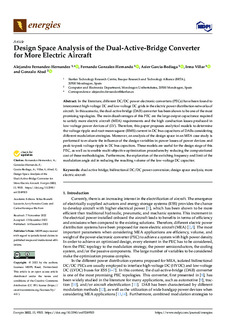| dc.rights.license | Attribution 4.0 International | * |
| dc.contributor.author | Abad, Gonzalo | |
| dc.contributor.other | Fernández Hernández, Alejandro | |
| dc.contributor.other | González-Hernando, Fernando | |
| dc.contributor.other | García Bediaga, Asier | |
| dc.contributor.other | Villar, Irma | |
| dc.date.accessioned | 2023-01-16T11:23:30Z | |
| dc.date.available | 2023-01-16T11:23:30Z | |
| dc.date.issued | 2022 | |
| dc.identifier.issn | 1996-1073 | en |
| dc.identifier.other | https://katalogoa.mondragon.edu/janium-bin/janium_login_opac.pl?find&ficha_no=171189 | en |
| dc.identifier.uri | https://hdl.handle.net/20.500.11984/5957 | |
| dc.description.abstract | In the literature, different DC/DC power electronic converters (PECs) have been found to interconnect high-voltage DC and low-voltage DC grids in the electric power distribution networks of aircraft. In this scenario, the dual-active-bridge (DAB) converter has been shown to be one of the most promising topologies. The main disadvantages of this PEC are the large output capacitance required to satisfy more electric aircraft (MEA) requirements and the high conduction losses produced in low-voltage power devices of (LV). Therefore, this paper proposes analytical models to determine the voltage ripple and root-mean-square (RMS) current in DC bus capacitors of DABs considering different modulation strategies. Moreover, an analysis of the design space in an MEA case study is performed to evaluate the influence of the design variables in power losses of power devices and peak-to-peak voltage ripple in DC bus capacitors. These models are useful for the design stage of this PEC, as well as to enable multi-objective optimization procedures by reducing the computational cost of these methodologies. Furthermore, the exploration of the switching frequency and limit of the modulation angle aid in reducing the resulting volume of the low-voltage DC capacitor. | en |
| dc.language.iso | eng | en |
| dc.publisher | MDPI | en |
| dc.rights | © 2022 The Authors | en |
| dc.rights.uri | http://creativecommons.org/licenses/by/4.0/ | * |
| dc.subject | dual active bridge | en |
| dc.subject | bidirectional DC/DC power conversion | en |
| dc.subject | design space analysis | en |
| dc.subject | more electric aircraft | en |
| dc.title | Design Space Analysis of the Dual-Active-Bridge Converter for More Electric Aircraft | en |
| dc.type | http://purl.org/coar/resource_type/c_6501 | |
| dcterms.accessRights | http://purl.org/coar/access_right/c_abf2 | en |
| dcterms.source | Energies | en |
| local.contributor.group | Sistemas electrónicos de potencia aplicados al control de la energía eléctrica | es |
| local.description.peerreviewed | true | en |
| local.identifier.doi | https://doi.org/10.3390/en15249503 | en |
| local.contributor.otherinstitution | https://ror.org/03hp1m080 | es |
| local.source.details | Vol. 15. N. 24. N. artículo 9503. | en |
| oaire.format.mimetype | application/pdf | |
| oaire.file | $DSPACE\assetstore | |
| oaire.resourceType | http://purl.org/coar/resource_type/c_6501 | en |
| oaire.version | http://purl.org/coar/version/c_970fb48d4fbd8a85 | en |








